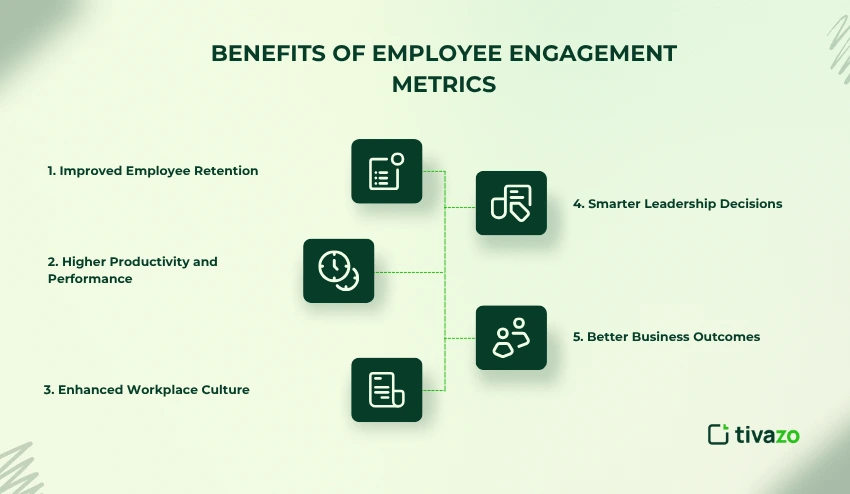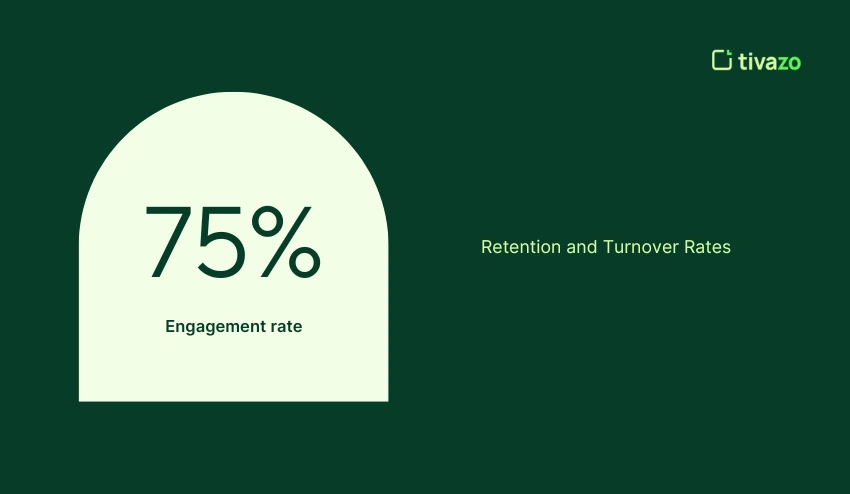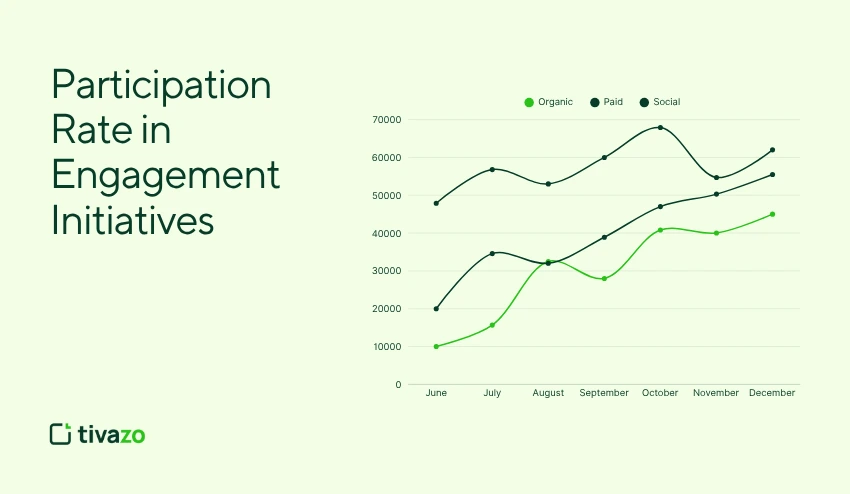In the modern competitive business environment, the motivation and commitment of employees are no longer optional, but a necessity. But how can you know the proof of engagement of your workforce?
The solution is to monitor the appropriate employee engagement metrics. These pieces of information provide a strong indication of employee satisfaction, productivity, and retention. Without them, companies are like driving in the dark.
Knowing what employee engagement metrics should be tracked can be the difference between a healthy workplace and a workplace that has high turnover and poor morale. Whether you use the well-known Employee Net Promoter Score (eNPS) or more specific metrics such as emotional safety or the frequency of feedback, the type of measure can determine how effectively you are able to act. This article reveals the best employee engagement metrics to monitor these days so that you can create a workforce that is not only efficient but also highly committed to the success of your organization.
What are Employee Engagement Metrics?
Employee engagement metrics are quantifiable values that assist companies in evaluating the degree of commitment, motivation, and satisfaction among employees. These KPIs measure several factors, including satisfaction scores of the workforce, employee retention rates, the number of recognitions, and the effectiveness of feedback. These metrics can help companies understand how employees feel and what they think about their experiences and engagement rates, which can help companies make decisions that can increase productivity and decrease turnover. Measuring the correct employee engagement measures is key in creating a good working culture and enhancing the overall business performance.
Why Employee Engagement Metrics Matter
Employee engagement is not a feel-good buzzword. It has a direct influence on business results like productivity, retention, innovation, and profitability. Gallup reports that companies with highly engaged teams have 21 percent higher profitability and 41 percent less absenteeism.
However, world rates of engagement fell to 21% in 2024, and this is a red flag to many organizations. To correct this, leaders should have employee engagement metrics that are credible and not based on surveys alone, but rather measures that capture the emotional, behavioral, and cultural pulse of the workforce.
Benefits of Employee Engagement Metrics
Measurement of employee engagement is not merely a matter of gathering information; it is a matter of discovering the potential of your workforce. These metrics enable organizations to know, act, and address the employee experience in meaningful and measurable ways.
The best things that businesses get by measuring the employee engagement metrics on a regular basis and in a proper manner are as follows.

1. Improved Employee Retention
Among the greatest advantages of applying the employee engagement metrics is the minimization of undesirable turnover. Companies can identify when employees are becoming dissatisfied by monitoring indicators such as eNPS and stay interview feedback, and act to prevent losing talent.
Employees will be more committed when they feel heard and respected. Engagement statistics can assist you in creating a culture that employees will be eager to remain in instead of attempting to get out of it.
2. Higher Productivity and Performance
Active workers are known to be highly productive and motivated. By using employee engagement data like the frequency of recognition or pulse survey scores, organizations can determine what contributes to high performance.
When employees are made to feel like they are supported and aligned with company objectives, productivity is bound to be the result. The insights assist managers in eliminating blockers and emulating high-performing environments in various departments.
3. Enhanced Workplace Culture
Measuring employee engagement metrics sheds light on cultural strengths and weaknesses. It tells you whether your values are lived out or are merely words on the wall.
Measuring such aspects as feedback loops, the level of trust, and psychological safety, leaders will be able to intervene to foster a healthier and more inclusive work environment. You can build a great culture through guesswork, but you can also build a great culture through data.
4. Smarter Leadership Decisions
The employee engagement metrics provide objective feedback to the leaders rather than blindly following the gut instinct. More strategic initiatives that do resonate with your workforce are the result of data-driven decision-making.
It ranges from determining the teams performing poorly to analyzing the effect of leadership styles, and such metrics provide a 360 view that will aid planning, communication, and execution.
5. Better Business Outcomes
The final advantage of employee engagement measures? Better business performance. Organizations that proactively engage in the measurement and enhancement of engagement all experience an increase in customer satisfaction, profitability, and innovation.
Gallup has shown that highly engaged teams in business are 21% percent more profitable. When the employees prosper, the bottom line prospers, and the first step is to know what to measure.
With the help of the appropriate employee engagement metrics, organizations will be able to turn their workplace into a place where people feel honored, aligned, and inspired.
10 Employee Engagement Metrics to Track
Monitoring the appropriate employee engagement metrics is essential to obtaining clear views on motivation, satisfaction, and loyalty of the workforce. Paying attention to these indicators, organizations will be able to take the necessary steps in advance and create a more engaged and productive team.
The following are the 10 best employee engagement measures that you ought to be tracking in these times so that you can remain a step ahead of developing a highly resilient and motivated workforce.
1. Employee Net Promoter Score (eNPS)
eNPS is an employee engagement metric that determines the extent to which employees are likely to recommend their workplace to other people. This one-question survey is a fast and effective measure of employee loyalty and employee satisfaction overall.
eNPS is easy to administer, which makes it a consistent measurement of the state of the workforce. The companies can easily compare these scores and monitor trends over time, and thus know what areas need to be addressed.
In order to make it as effective as possible, conduct eNPS surveys every three months and compare the answers by department, position, or seniority. This level of detail can reveal exact areas of engagement difficulty, so it can be improved in those areas.
2. Retention and Turnover Rates
Retention and turnover rates are one of key employee engagement metrics that show how well your company retains its talent. Retention rate is a measurement of the number of employees that remain, and turnover rate is a measurement of the number of employees that leave.
The high turnover is usually an indication of disengagement or dissatisfaction, which negatively affects productivity and morale. Gallup estimates that disengaged employees are 2.5 times more likely to quit, which is why these measures are essential to workforce stability.

In order to have a better understanding, it is necessary to differentiate between voluntary and involuntary turnover and examine exit interview data. This subtle understanding reveals underlying factors that lead to departures, and this will enable you to come up with effective retention strategies.
3. Pulse Survey Scores
Pulse surveys refer to brief but regular questionnaires that help to obtain real-time measures of employee engagement. They also target certain areas like recognition, workload, or well-being, and give real-time information about how employees feel.
The pitfalls of long and rare surveys are avoided as a result of regular pulse surveys, and survey fatigue is minimized. CultureMonkey states that such a continuous feedback system ensures that leaders are able to react swiftly to new engagement problems.
Questions rotated monthly are good because this covers a wide area, and the companies can have a good and updated image of employee engagement as time passes by.
4. Absenteeism Rate
Absenteeism rate is an essential behavioral employee engagement metrics that monitors the percentage of unplanned days that employees do not work. Regular absenteeism may be a sign of burnout, poor morale, or some illness in the labor force.
Leapsome identifies absenteeism as one of the more practical metrics that tend to show more underlying engagement issues than surveys can detect. Keeping track of this measure will allow organizations to determine when their employees might need assistance.
By supplementing your data on absenteeism with qualitative-based inputs such as manager 1:1 meetings, you can be able to distinguish between disengagement and unavoidable health-related absences to make your analysis more accurate.
5. Feedback and Recognition Metrics
Monitoring feedback and recognition level is a valuable employee engagement metric that demonstrates the frequency of employee appreciation. It has been established that a recognition culture enhances motivation, satisfaction, and general engagement.
Patterns of recognition indicate the vibrancy of workplace relationships and the efficiency of leadership, as indicated by CultureMonkey. Frequent, positive reinforcement helps the employees remain dedicated and efficient.
This information can be collected easily by implementing real-time recognition platforms so that organizations can examine trends based on team or manager and encourage positive behavior.
6. Employee Engagement Score
The employee engagement score is a combination of the results of various surveys that covered motivation, satisfaction, and commitment. This is a broad employee engagement metrics and thus it gives an overall picture of how the workforce is engaged.
CultureMonkey highlights the separation of this score into driver elements such as autonomy, leadership, and communication to have a clearer perception of what drives engagement levels.
With such an in-depth analysis, organizations can focus their interventions on particular issues and thus engage in more focused and effective interventions.
7. Participation Rate in Engagement Initiatives
Participation rate indicates the percentage of employees who are engaged and participate in the surveys, focus groups, and other programs, which is one of the employee engagement metrics showing the level of employee involvement and trust.

Low participation rates can imply a lack of engagement or doubt in the use of feedback. To get the real voice of your employees, high participation is necessary.
Transparency and responding to feedback are established practices to increase engagement, which in turn improves the validity of all other indicators of engagement.
8. Managerial Engagement Metrics
Managerial engagement is a very important yet not commonly measured employee engagement metrics. According to Gallup, there have been massive drops in manager engagement, particularly among younger and female managers, which can impact whole teams in a negative way.
Managers are the frontline leaders who affect the daily experience of the employees, and, therefore, keeping track of their engagement allows organizations to customize leadership development and assistance.
Manager-specific eNPS and feedback quality monitoring will give actionable data to enhance managerial performance and, consequently, engagement levels among the team members.
9. Qualitative Feedback
Numerics do not give the whole picture when measuring the engagement of employees. Exit interviews, stay interviews, and one-on-one meetings provide qualitative feedback that shows the true causes of employee decisions.
The use of AI-based sentiment analysis will allow picking up nuances in the open-ended feedback that are not usually captured by more traditional approaches to providing insights into engagement drivers.
The integration of quantitative measures with deep qualitative data enables organizations to have a better understanding of the employee experience and allows them to build more impactful engagement strategies.
10. Work-Life Balance Metrics
In the contemporary hybrid working reality, work-life balance is a crucial employee engagement metric. Gallup emphasizes its great impact on employee wellness and engagement.
The measurement of this metric includes surveying employees regarding the workload, stress level, and satisfaction with flexibility, as well as absenteeism and overtime indicators.
Work-life balance enhances healthier and happier employees, which directly increases general participation and decreases burnout.
Monitoring these main employee engagement indicators will enable organizations to create a successful working culture and achieve improved business performance.
Best Tool for Tracking Employee Engagement Metrics
Speaking about the most effective tool used to monitor the employee engagement metrics, Tivazo is an efficient, comprehensive platform that could be used to track the satisfaction, retention, and motivation levels in the workforce accurately. Tivazo provides real-time pulse surveys, analytics, and simple dashboards to make it easy to track the most important employee engagement KPIs.

Tivazo allows companies to gain significant insights about employee sentiment, recognition, and productivity by offering customizable survey options and automated feedback collection. Users state that Tivazo has a friendly interface and strong reporting capabilities that enable leaders to make swift decisions based on engagement data to enhance the overall experience of the workforce. Head to Tivazo to see how this new tool can revolutionize your employee engagement strategy now.
Conclusion
Measuring the proper employee engagement metrics enables organizations to develop a productive, motivated, and loyal workforce. Leaders can get a 360-degree picture of engagement by using quantitative data on eNPS and turnover rates with qualitative insights in the form of feedback and 1:1s.
Thoughtful application of these metrics, without causing survey fatigue, and transparent action on results will make your organization stand out. Engagement is a process and not a goal, and it is one that must be measured, understood, and nurtured.
Are you ready to reinvent your workplace by measuring what counts?




